
Prof. Amnon Albeck
CV
Education
BSc, Chemistry, Bar Ilan University, 1982
PhD, Organic Chemistry, The Weizmann Institute of Science, 1988.
Post-doc, Biochemistry, Brandeis University, USA, 1990.
Appointments
On the faculty of the Department of Chemistry, Bar Ilan University since 1990.
Full Prof. since 2008.
Chairman of the Department of Chemistry 2008-2011.
Vice Rector, Bar Ilan University 2014-2020.
Rector, Bar Ilan University since October 2020
Member of the “Marcus Center for Medicinal Chemistry” at Bar Ilan.
Academic & administrative Activities
At Bar Ilan
2012 – present: Member of University’s various committees
2011 – 2014: Member of the University’s Appointment Committee
2011 – 2014: Member of the Departmental Teaching Committee
2010 – present: Member of the University’s Senate
1998 – 2008: Member of The Academic Steering Committee, the Biophysics program
1996 – 2020: Member of the University Safety Council
Outside Bar Ilan
2014 - 2020 : Member of The Board of Executives, The National Institute for Testing and Evaluation
2013 – 2020: Member of The Inspection Committee, The Israel Chemical Society
2011 – 2013: Member of the Fulbright Postdoctoral Fellowship Committee, US-Israel Educational Foundation
2010 – 2018: Member of the National Chemical Education Committee, Ministry of Education
2003 – 2011: Advisor to the GIF
2003 – 2007: Member of The Academic Steering Committee, Carbohydrates Center, Ben Gurion University
1997 – 2000: Member of The Board of Executives, The Israel Chemical Society
Research
Organic chemistry, Peptides and peptidomimetics, Biochemistry, Enzymology, Enzyme mechanisms, Enzyme inhibition, Proteases, Medicinal chemistry, Computational biochemistry.
Particular research areas (projects):
- Organic synthesis, peptides and peptidomimetics: amino acid- and peptide bond replacement, N- and C-terminal functional groups.
- Enzyme catalysis and inhibition mechanisms. The catalytic machinery of proteases, acid-base catalysis, pKa and protonation state of catalytic residues, the mechanism of inhibition by unique inhibitors.
- Development of inhibitors for enzymes with potential therapeutic applications.
- Computational biochemistry: enzyme mechanisms, development of computer-assisted drug design tools and their implication in inhibitor- and drug design.
- Medicinal chemistry: anti-necrotic compounds, anti-cancer Te compounds, treatment for autism.
Interesting? Want to learn more?
Our research focuses on understand enzyme mechanism and inhibition and to design and develop drugs targeted towards enzymes. The research is interdisciplinary in nature, combining synthetic organic chemistry, biochemistry, enzymology, computational chemistry, and cellular biology.
Enzyme Reaction Mechanisms
Understanding the mode of action of enzymes at the molecular level has important potential applications, as it opens up possibilities to selectively control or modulate such activities. This approach is essential for basic research, as well as for the development of new drugs and other biologically active compounds.
We study proteolytic enzymes, enzymes that hydrolyze (cleave) proteins and peptides which are involved in many biological processes. The research combines experimental research with computational biochemistry. Experiments include biochemical analysis, enzyme kinetics, chemical synthesis, and analytical techniques such as NMR and X-ray crystallography.
How does acid/base catalysis in serine proteases really work?
Computational Methods development
Computational tools are very instrumental in enzyme mechanism studies. One of the most usefull methods is QM/MM, which combines in an itterative process QM calculations on a smal active-site molecular cluster and MM calculations for the rest of the protein and its environment. We developed a new methodology, MD-QM/SCRF(VS), which combines molecular dynamics (MD) simulations with quantum mechanical (QM) calculations of the enzyme. In the QM calculations the enzyme is treated as a two layer system: the inner layer, a large molecular cluster simulating the enzyme active site, is explicitly calculated. The outer layer, the rest of the protein and its environment, is treated as a uniform continuum, a "virtual solvent (VS)", characterized by a dielectric constant which is calibrated by experimental data. This methodology has some advantages over common computational tools. It has been successfully applied for the study of structure, protonation states, pKa values and detailed molecular-level mechanisms of enzyme catalysis and inhibition.
The QM/SCRF(VS) concept
Drug Design and Delivery
This research involves the design and synthesis of enzyme inhibitors, drug candidates and drug delivery systems, as well as evaluation of their activity at various levels, from in-vitro studies to in-vivo animal model experiments.
One project, in collaboration with Prof. Gary Gellerman from Ariel University, focuses on the development of novel methodologies for the preparation of targeted multi-drug delivery systems, with the aim to recruit anti cancer drugs and drug candidates that failed clinical trials due to their toxicity.
Another project, with Prof. Ilana Nathan from Ben Gurion University and Soroka Medical Center, concentrates on understanding basic biological processes involved in necrotic cell death and on the development of protease inhibitors to treat necrosis. This project has produced very encouraging in-vivo results in three animal model systems.
A decade-long collaboration with Prof. Michael Albeck and Prof. Benjamin Sredni from Bar Ilan University deals with the development of tellurium-based bioactive compounds as potential anti-cancer and anti-viral drugs. Here, too, animal studies demonstrated the therapeutic potential of these compounds.
Other projects in the pharmaceutical field and in an industrial application are underway in our lab.
Representative 3D structure of an enzyme active site (cyan) interacting with its inhibitor (magenta). The structure emerged from computational studies.
Computer-Assisted Drug Design Tools Development
One central research direction in our lab involves the development of novel computer-assisted drug design (CADD) tools to assist medicinal chemists and the pharmaceutical industry in the design of new bioactive compounds. In a project that may help to overcome the problem of mutational drug resistance, led by Prof. Michael Shokhen in our lab, we develop computational tools for the design of new antibacterial and antiviral drugs based on enzyme inhibitors. Common drug design tools deal with non-covalent inhibitors, which eventually suffer from mutational drug resistance. The emergence of resistant bacterial and viral strains, as well as cancer cells, has become a major problem in modern medicine. The methodology we develop is applicable to transition-state analog enzyme inhibitors. These reversible covalent inhibitors interact directly with the catalytic machinery of the enzyme, which is not subject to mutations. While the common CADD tools are either structure-based or ligand / pharmacophore-based methodologies, our approach can be classified as a mechanism-based drug design tool. Indeed, our previous mechanistic studies on enzyme catalysis and inhibition provided the basis for the development of this novel CADD methodology.
A description of the EMBM methodology for virtual screening and rational design of protease inhibitors.
Peptidomimetics
Peptide analogs, in which one or more functionalities have been altered, are promising for many applications in drug development, diagnostics, and mechanistic studies. We develop innovative synthetic methods for the preparation of such peptide analogs, applying them for the synthesis of novel enzyme inhibitors.
These inhibitors may serve mechanistic research goals, or may be developed for drug discovery projects. Their functional alterations may include the introduction of reactive functional groups to covalently interact with a target enzyme, conversion of a peptide bond to a metabolically stable isostere, or design of scaffolds that mimic small peptides.
Chemo-enzymatic synthesis of a variety of optically active functionalized building blocks for peptidomimetics (red) from a single optically active precursor (blue), obtained by a stereoselective enzymatic hydrolysis of a prochiral starting material (green).
Looking to the Future
As a research group that combines both experimental and computational research tools, and that emphasizes both basic-mechanistic and applied research, we are committed to the improvement and further development of our drug design computational methodologies and their application in practical drug development projects. Ongoing projects as well as future projects are expected to yield biochemical information and bioactive compounds that together will provide the grounds for the development of new drugs.
Publications
Recent Publications (past 10 years)
Shokhen, M.; Khazanov, N.; Albeck, A. The Mechanism of Papain Inhibition by Peptidyl Aldehydes. Proteins 2011, 79, 975-985.
Shokhen, M.; Traube, T.; Vijayakumar, S.; Hirsch, M.; Uritsky, N.; Albeck, A. Differentiating Serine and Cysteine Proteases Mechanism by New Covalent QSAR Descriptors. ChemBioChem 2011, 12, 1023-1026.
Gellerman, G.; Waintraub, S.; Albeck, A.; Gaisin, V. One-Pot Synthesis of Novel Antiproliferative 9-Aminoacridines. Eur. J. Org. Chem. 2011, 22, 4176-4182.
Redko, B.; Albeck, A.; Gellerman, G. Facile synthesis and antitumor activity of novel N(9) methylated AHMA analogs. New J. Chem. 2012, 36, 2188-2191.
Uritsky, N.; Shokhen, M.; Albeck, A. The catalytic machinery of rhomboid proteases. Combined MD and QM simulations. J. Chem. Theory Comput. 2012, 8, 4663-4671.
Cohen, M.; Bretler, U.; Albeck, A. Peptidyl cyclopropenones: reversible inhibitors, irreversible inhibitors, or substrates of cysteine proteases? Protein Sci 2013, 22, 788-799.
Sharabi-Ronen, Y.; Levinger, S.; Ben-Dahan Lellouche, M.; Albeck, A. Anti-neoplastic Activity of 1,3-Diaza-2-functionalized-adamantan-6-one Compounds Against Melanoma Cells. Med. Chem. 2014, 10, 27-37.
Traube, T.; Shokhen, M.; Albeck, A. Application of EMBM for Structure-Based Design of Warheads for Protease Inhibitors. Mol Inf 2014, 33, 36-42.
Traube, T.; Shokhen, M.; Albeck, A. A New Method for Filtering of Reactive “Warheads” of Transition-State Analog Protease Inhibitors. Eur J Med Chem 2014, 77C, 134-138.
Shokhen, M.; Hirsch, M.; Khazanov, N.; Ozeri, R.; Perlman, N.; Traube, T.; Vijayakumar, S.; Albeck, A. From Catalytic Mechanism to Rational Design of Reversible Covalent Inhibitors of Hydrolases. Isr J Chem 2014, 54, 1137-1151.
Gilad, Y.; Firer, M. A.; Rozovsky, A.; Ragozin, E.; Redko, B.; Albeck, A.; Gellerman, G. "Switch off/switch on" regulation of drug cytotoxicity by conjugation to a cell targeting peptide. Eur J Med Chem 2014, 85, 139-146.
Rozovsky, A.; Regozin, E.; Oron-Herman, M.; Albeck, A.; Gellerman, G. Synthesis of novel antitumor carbazole-amonafide structural hybrids. Eur J Org Chem 2015, 1811-1818.
Zats, G. M.; Kovaliov, M.; Albeck, A.; Shatzmiller, S. Antimicrobial Benzodiazepine-Based Short Cationic Peptidomimetics. J Pept Sci 2015, 21, 512-519.
Lapidot, I.; Albeck, A.; Gellerman, G.; Shatzmiller, S.; Grynszpan, F. 1,4-Dihydropyridine Cationic Peptidomimetics with Antibacterial Activity. Int J Pept Res Ther 2015, 21, 243-247.
Redko, B.; Ragozin, E.; Bazylevich, A.; Tuchinsky, H.; Albeck, A.; Shekhter Zahavi, T.; Oron-Herman, M.; Kostenich, G.; Gellerman, G. Synthesis, drug release and biological evaluation of new anticancer drug-bioconjugates containing somatostatin backbone cyclic analog as a targeting moiety. Pept Sci 2015, 104, 743-752.
Gilad, Y.; Noy, E.; Senderowitz, H.; Albeck, A.; Firer, M. A.; Gellerman, G. Synthesis, biological studies and molecular dynamics of new anticancer RGD-based peptide conjugates for targeted drug delivery. Bioorg Med Chem 2016, 24, 294-303.
Lapidot, I.; Baranes, D.; Pinhasov, A.; Gellerman, G.; Albeck, A.; Grynszpan, F.; Shatzmiller, S. E. alpha-Aminoisobutyric acid leads a fluorescent syn-bimane LASER probe across the blood-brain barrier. Med Chem 2016, 12, 48-53.
Uritsky, N.; Shokhen. M.; Albeck, A. Stepwise vs. Concerted Mechanism in General Base Catalysis by Serine Proteases. Angew Chem Int Ed Engl 2016, 55, 1680-1684.
Gilad, Y.; Noy, E.; Senderowitz, H.; Albeck, A.; Firer, M. A.; Gellerman, G. Dual-drug RGD conjugates provide enhanced cytotoxicity of melanoma and non-small lung cancer cells. Pept Sci 2016, 106, 160-171.
Ragozin, E.; Redko, B.; Tuchinsky, E.; Rozovsky, A.; Albeck, A.; Grynszpan, F.; Gellerman, G. Bio-Labile Peptidyl Delivery Systems Towards Sequential Drug Release. Pept Sci 2016, 106, 119-132.
Silberman, A.; Kalechman, Y.; Hircsh, S.; Erlich, Z.; Sredni, B.; Albeck, A. The anti cancer activity of organotelluranes: potential role in integrin inactivation. ChemBioChem 2016, 17, 918-927.
Levinger, S.; Hirsch, S.; Albeck, A. Lithium Aluminum Hydride Assay Suitable for the Organic Chemistry Laboratory. ChemistrySelect 2016, 4, 756-758.
Gilad, Y.; Waintraub, S.; Albeck, A.; Gellerman, G. Synthesis of novel protected Nα(ω-Drug) amino acid building units for facile preparation of anticancer drug-conjugates. Int. J. Pept. Res. Ther. 2016, 22, 301-316.
Zer-Aviv, P.; Shubely, M.; Moskovits, Y.; Viskind, O.; Albeck, A.; Vertommen, D.; Ruthstein, S.; Shokhen, M.; Gruzman, A. A new oxopiperazin-based peptidomimetic molecule inhibits prostatic acid phosphatase secretion and induces prostate cancer cells apoptosis. ChemistrySelect 2016, 1, 4658-4667.
Silberman, A.; Albeck, M.; Sredni, B.; Albeck, A. The ligand substitution reactions of the tellurium compound AS-101 in physiological aqueous and alcoholic solutions. Inorg Chem 2016, 55, 10847-10850.
Shokhen, M.; Albeck, A. How Does the Exosite of Rhomboid Protease Affect Substrate Processing and Inhibition? Prot. Sci. 2017, 26, 2355-2366.
Avraham, Y.; Berry, E. M.; Donskoy, M.; Abu Ahmad, W.; Vorobiev, L.; Albeck, A.; Mankuta, D. Beta-carotene as a novel therapy for the treatment of “autistic like behavior” in animal models of autism. Behav. Brain Res. 2019, 364, 469-479.
Nihamkin, M.; Isac, A.; Albeck, A.; Mastai, Y.; Toker, Y. Gas Phase Bond Formation in Dipeptide Clusters. J. Phys. Chem. Lett. 2020, 11, 10100-10105.
Ayyathan, D. M.; Levy-Cohen, G.; Shubely, M.; Boutros-Suleiman, S.; Lepechkin-Zilbermintz, V.; Shokhen, M.; Albeck, A.; Gruzman, A.; Blank, M. Development and characterization of SMURF2-targeting modifiers. J. Enz. Inhib. Med. Chem. 2021, 36, 401-409.
Khalfin, B.; Lichtenstein, A.; Albeck, A.; Nathan, I. Targeting necrosis: elastase-like protease inhibitors curtail necrotic cell death both in-vitro and in three in-vivo disease models. J. Med. Chem. 2021, 64, 1510-1523.
Avraham, Y.; Mankuta, D.; Lipsker, L.; Vorobiev, L.; Patael, S.; Hassid, G.; Berry, E. M.; Albeck, A. Beta-carotene derivatives as novel therapy for the prevention and treatment of autistic symptoms. Bioorg. Chem. 2021, 115, 105224.
Lerman, E.; Levinger S.; Albeck, A. Optically active functionalized building blocks for peptidyl olefin peptidomimetics. ChemistrySelect 2021, 6, 7912-7918.
Courses
Past and present:
84-205 Organic Chemistry 1
84-206 Organic Chemistry 2
84-305 Organic Chemistry Lab 2
84-364 Secondary Metabolism
84-964 Enzyme Catalysis and Mechanisms
84-965 Enzymatic Catalysis: Methods for Research, Control and Development
80-236 Organic Chemistry 2 for Biology-major students
80-380 Biochemistry of enzymatic systems
80-757 Organic Chemistry lab for pre-med students
80-759 Organic Chemistry 2 for pre-med students
Research Group
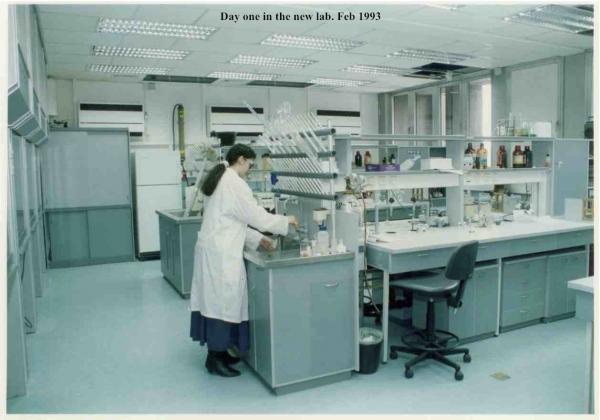
Current group members
Dr. Shlomo Levinger z"l (passed away on January 15, 2021), Research associate
Dr. Michael Shokhen, Research associate
Dr. Sveta Furman, lab manager
Noga Kaufman, Ph.D. student
Golda Hassid, Ph.D. student
Ron Schwartz, Ph.D. student
Shahaf Peleg, M.Sc. student
Sivan Bahar, M.Sc. student
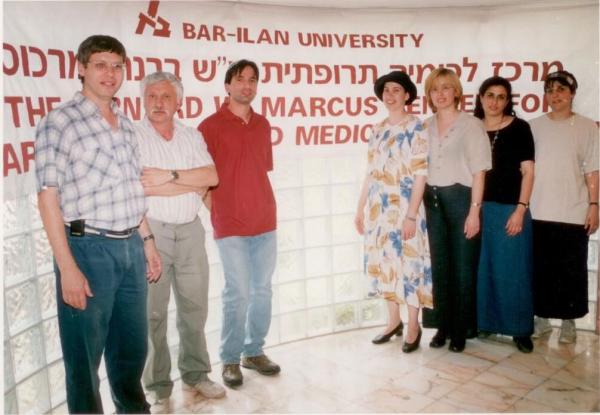


Past group members
Graduate students
Rachel Klimovsky, M.Sc. (1993)
Limor Weiss, M.Sc. (1995)
Gary Estreicher, M.Sc. (1995)
Shulamit Fluss, M.Sc. (1995)
Hana Weitman, M.Sc. (1995)
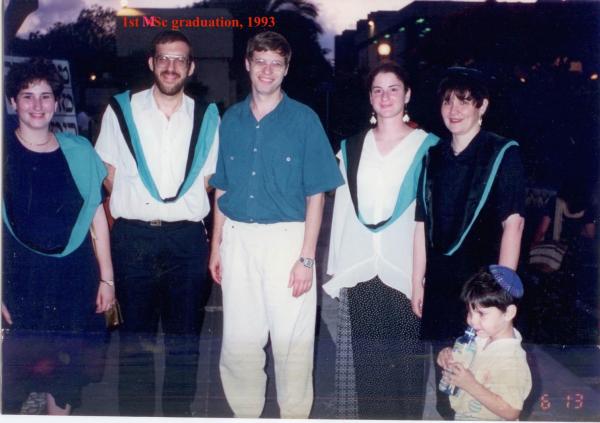
Eduard Rogatsky, Ph.D. (1998)
Sharon Kliper, Ph.D. (1999)
Rachel Persky, Ph.D. (1999)
Nurit Perlman, Ph.D. (2000)
Oded Meroz, M.Sc. (2000)
Sima Mirilshvili, M.Sc. (2000)

Revital Yefidoff, Ph.D. (2002)
Nadia Silverman, Ph.D. (2004)
Yosi Bechor, Ph.D. (2004)
Rachel Nakash, Ph.D. (2005)
Sigal Yosef, Ph.D. (2005)
Sima Mirilshvili, Ph.D. (2005)
Shira Adler, M.Sc. (2005)
Alexander Mainfeld, M.Sc. (2005)
Naama Hassid, M.Sc. (2006)
Hani Algawi, M.Sc. (2007)
Miri Ben Dahan, M.Sc. (2007)
Marianna Kishinevsky, Ph.D. (2008)
Tamar Traube, M.Sc. (2008)
Meital Cohen, Ph.D. (2008)
Netaly Hazanov, Ph.D. (2008)
Maya Chazan, Ph.D. (2008)
Tamara Brider, M.Sc. (2008)
Rami Kriger, M.Sc. (2008)
Miriam Nakash, M.Sc. (2008)
Avraham Klein, M.Sc. (2009)
Marina Kobaliov, M.Sc. (2009)
Galina Zats, M.Sc. (2009)
Tzachi Shalit, M.Sc. (2009)
Moran Gilboa, M.Sc. (2010)
Uriel Bartler, M.Sc. (2010)
Yifat Sharabi-Ronen, Ph.D. (2010)
Keren Schultz, Ph.D. (2010).
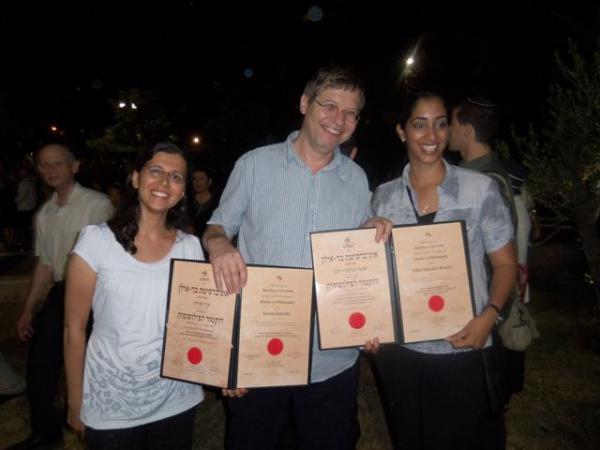
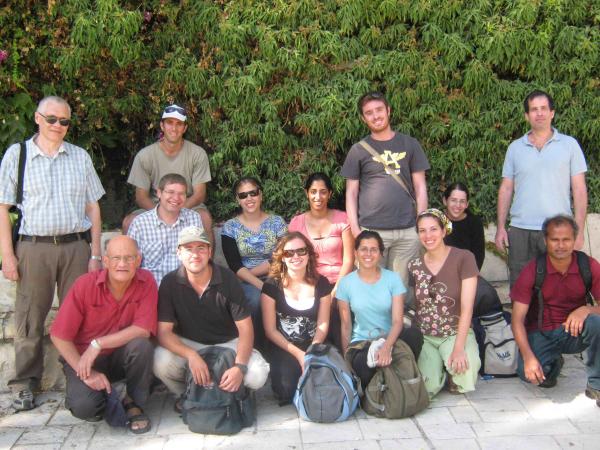
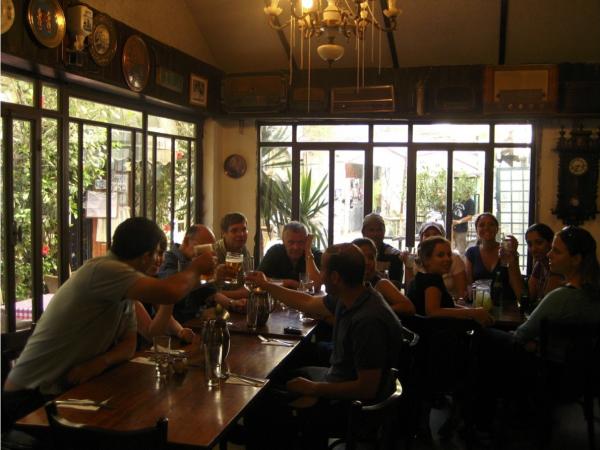
Miri Ben Dahan, Ph.D. (2011)
Sagiv Waintraub, M.Sc. (2011)
Yosef Gilad, M.Sc. (2012)
Michal Hirsch, M.Sc. (2012)
Boris Redko, M.Sc. (2012)
Sofia Levi, M.Sc. (2012)
Rami Kriger, Ph.D. (2013)
Keti Lerman, Ph.D. (2013)
Elena Ragozin, M.Sc. (2013)
Naama Rubinstein, Ph.D. (2014)
Tamar Traube, Ph.D. (2014)
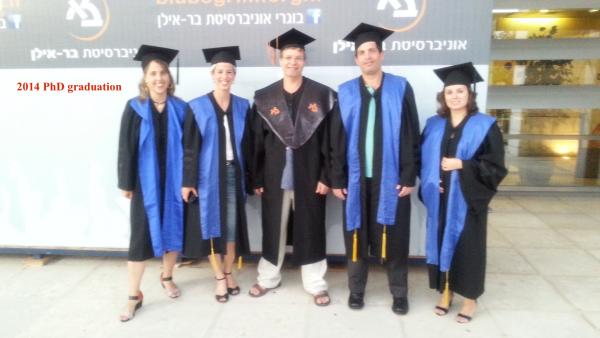
Marina Yarovoy, M.Sc. (2014)
Alon Zilberman, Ph.D. (2014)

Inbal Lapidot, Ph.D. (2014)
Shira Hirsch, M.Sc. (2014)
Alex Rozovsky, M.Sc. (2015)
Sigal Patael, Ph.D. (2015)
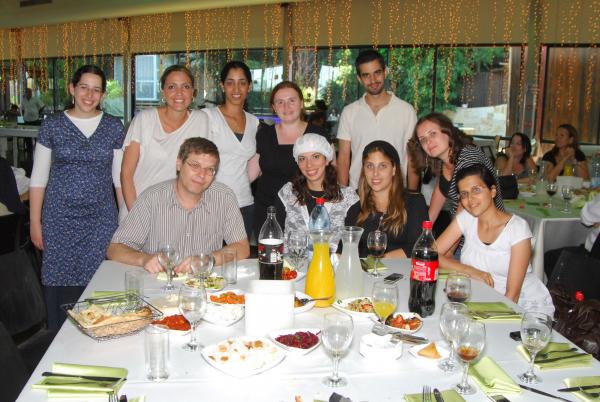
Yosef Gilad, Ph.D. (2016)
Tzachi Shalit, Ph.D. (2016)
Avinoam Isac, M.Sc. (2016)
Ayelet Gedalya-Bremer, M.Sc. (2016)
Ruti Bornestein, M.Sc. (2016)
Moran Mazuz, Ph.D. (2016)
Boris Redko, Ph.D. (2016)
Malki Ginzberg, M.Sc. (2016)
Noga Kaufman, M.Sc. (2018)
Golda Huri, M.Sc. (2018)
Ron Schwartz, M.Sc. (2018)
Avinoam Isac, Ph.D. (2021)
Kobi Wolfman, Ph.D. (2021)
Yael Yashar-El, M.Sc. (2021)
Post-doctoral fellows
Nurit Perlman (2000-2001)
Guy Patchornic (2004)
Sigal Yosef (2004-2005)
Vijayakumar Subramaniam (2008-2010)
Former lab manager
Dr. Sigal Patael, 2015-2017
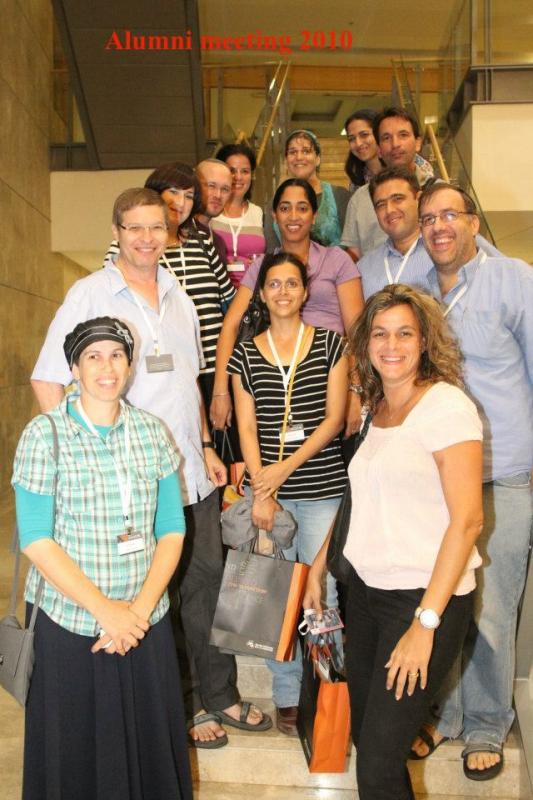
Last Updated Date : 03/03/2024



